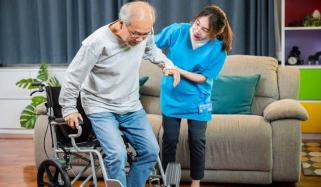
People with texting and smartphone obsession are in huge trouble as the shape of the spine could be triggering major health risks.
As per Daily Mail, a health expert has warned the danger excessive phone usage can cause with bent back from shortness of breath to not having control on urination.
Dr Kuo-Pin Wu, a traditional Chinese medicine doctor said that smartphones have become part of our daily lives but the constant bending and looking down, over time, might reshape the curved of our spines.
Warning people about Kyphosis, also known as hunchbacks, he said that the natural curve in the upper back is usually between 20 to 45 degrees on X-ray but if the curve is observed to have angle more than 50, it is classified as kyphosis.
As per Dr. Wu, the most common cause of this transition is "habitual forward head and neck posture, such as frequent looking down at screens while working."
Hunchbacks is becoming a common condition, affecting more than 3 million Americans per year.
Aside from looking unnatural, hunchbacks also cause lot of health problems including chronic pain, gradual loss of walking ability and balance issues.
The Cleveland Clinic also shared similar statement to Dr. Wu adding how the poor posture can also cause shortness of breath as the chest is compressed.
Kyphosis can also cause incontinence as the hunching over compress the nerves in the spine which disturbs the communication between the brain and the muscles responsible for bladder control.
The medicine doctor also revealed that people with severe hunchback issues have the possibility of having spinal degeneration.
Spinal degeneration, which usually occurs in adults over 40, is the gradual loss of normal structure and function of the spine, which over time can lead to collapsing stage, which could lead a person to wheelchair or permanent bed rest.
It can also be the reason behind rapid decline in lungs and stomach function, leading to indigestion and bloating.
To get rid of hunchback, Dr. Wu suggested several exercises including overhead arm stretched and reducing screen time.
He guided, "Stretch your arms forward and raise them overheard. Start with your palms facing each other, then rotate them outward as your arms lift. Tilt your head slightly upward."
"As your arms rise, step forward with your right foot, lifting your left heel so that only your toes touch the ground. Return to a neutral standing position, then step forward with your left foot and repeat the movement," Dr Kuo-Pin Wu added.
According to Dr. Wu this exercise will help stretch the muscles and joints in your back, boost oxygen intake and support lymphatic circulation under your arms.
To get better result, Dr Kuo-Pin Wu recommended the exercise to be done several times a day.















